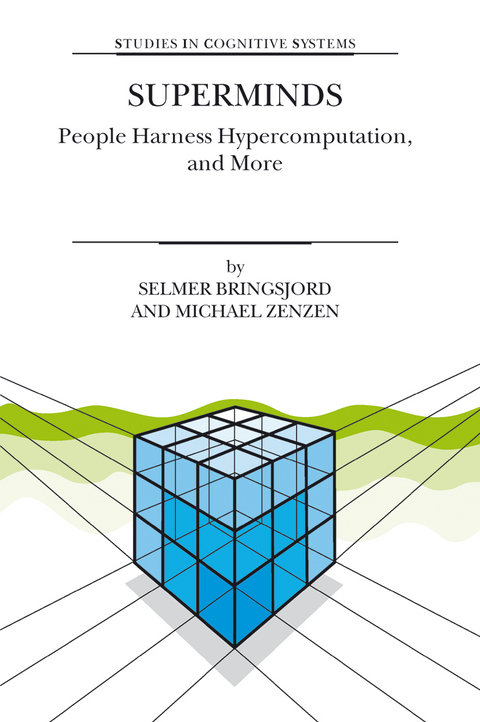
Superminds
Springer-Verlag New York Inc.
978-1-4020-1094-1 (ISBN)
1 What is Supermentalism.- 1.1 Computationalism is Dead.- 1.2 Are We Serious.- 1.3 What is Dead? — Propositional Answer.- 1.4 The Centrality and Logic of Personhood and Cognition in the Present Project.- 1.5 The Turing Test.- 1.6 Pictorial Overview of Supermentalism.- 1.7 Propositional Overview of Supermentalism.- 1.8 A Primer on Hypercomputation.- 1.9 An Alternative Characterization of Supermentalism.- 1.10 Classifying Supermachines/Superminds.- 1.11 Previewing What’s To Come.- 2 A Refutation of Penrose’s Gödelian Case.- 2.1 Introduction.- 2.2 The Main Positions on AI.- 2.3 Why “Weak” AI is Invulnerable.- 2.4 Background for Penrose’s New Gödelian Case.- 2.5 The Core Diagonal Argument.- 2.6 Formal Machinery.- 2.7 Formalizing Penrose’s Diagonal Argument.- 2.8 Penrose’s Dilemma: Either Way a Fallacy.- 2.9 Possible Replies.- 2.10 Given G, The Other Possibilities.- 2.11 Penrose’s Last Chance.- 2.12 Conclusion; The Future.- 2.13 Distilling Penrose’s Promising Intuitions.- 3 The Argument from Infinitary Reasoning.- 3.1 Introduction.- 3.2 Discarding Some Initial Objections.- 3.3 The Need for Open-Mindedness.- 3.4 Plan of the Chapter.- 3.5 Reasoning as Computation in First-Order Logic.- 3.6 Sharpening Infinitary Reasoning.- 3.7 The Argument from Infinitary Reasoning.- 3.8 Dialectic.- 3.9 Simon’s Dream and Mental Metalogic.- 3.10 Mental MetaLogic: A Glimpse.- 4 Supermentalism and the Fall of Church’s Thesis.- 4.1 Background.- 4.2 Mendelson’s Attack.- 4.3 Mendelson’s Rebuttal.- 4.4 Attacking Church’s Thesis.- 4.5 Objections.- 4.6 Our Arg3 in Context: Other Attacks on CT.- 5 The Zombie Attack on Computationalism.- 5.1 Introduction.- 5.2 Dennett’s Dilemma.- 5.3 Targeting Computationalism.- 5.4 Can Dennett Dodge His Dilemma.- 5.5 Two Final Moves.-5.6 Conclusion.- 6 The Argument from Irreversibility.- 6.1 Introduction.- 6.2 The Computational Conception of Mind.- 6.3 Rudiments of Reversibility.- 6.4 The Argument from Irreversibility.- 6.5 Dialectic.- 7 What are We? Where’d We Come From.- 7.1 What, at Bottom, Are We.- 7.2 Perhaps Superminds are Simple Souls.- 7.3 How’d We Get Here.- 7.4 Toward the Second Argument for Doubting that Evolution Produced Us.- 8 Supermentalism and the Practice of AI.- 8.1 Toward the Final Stage of the Project.- 8.2 The Eight-fold Prescription for the Practice of AI.- 8.3 P1: Building Consciously Harnessable Hypercomputers is Hard, but Push Ahead Anyway.- 8.4 P2: Focus on Building Artificial Animals (Zombanimals).- 8.5 P3: Pursue What We have Dubbed “Psychometric AI”.- 8.6 P4: Take Experimental Psychology of Reasoning Seriously.- 8.7 P5: Be Brutally Honest about the Limitations of Standard Schemes for Knowledge Representation and Reasoning.- 8.8 P6: Investigate Language Acquisition.- 8.9 P7: Pursue the Mathematical Modeling of Mentation, Independent of Even Future Implementation.- 8.10 P8: Put Connectionism in its Place.
| Erscheint lt. Verlag | 31.3.2003 |
|---|---|
| Reihe/Serie | Studies in Cognitive Systems ; 29 |
| Zusatzinfo | XXX, 339 p. |
| Verlagsort | New York, NY |
| Sprache | englisch |
| Maße | 155 x 235 mm |
| Themenwelt | Geisteswissenschaften ► Philosophie ► Logik |
| Informatik ► Theorie / Studium ► Künstliche Intelligenz / Robotik | |
| ISBN-10 | 1-4020-1094-X / 140201094X |
| ISBN-13 | 978-1-4020-1094-1 / 9781402010941 |
| Zustand | Neuware |
| Haben Sie eine Frage zum Produkt? |
aus dem Bereich


